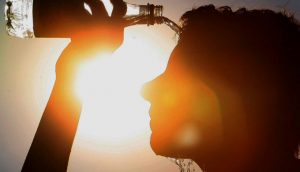 By Bizodisha Bureau, Bhubaneswar, June 3, 20243: Ninety-nine persons are suspected to have died due to heatstroke in Odisha over the past 72 hours as intense heatwave conditions gripped the state. The state government has confirmed 26 deaths so far.
By Bizodisha Bureau, Bhubaneswar, June 3, 20243: Ninety-nine persons are suspected to have died due to heatstroke in Odisha over the past 72 hours as intense heatwave conditions gripped the state. The state government has confirmed 26 deaths so far.
The Special Relief Commissioner’s (SRC) office said most of these deaths were reported from the western Odisha districts.
The deaths in Odisha have been predominantly reported from the districts of Bolangir, Sambalpur, Jharsuguda, Keonjhar, Sonepur, Sundergarh, and Balasore. A high-level meeting was held at the level of Chief Secretary and instructions were issued to the District Collectors to ensure implementation of heatwave advisories and precautionary measures.
The government has ordered a postmortem of all suspected heatstroke deaths.
Of the total 141 alleged heatstroke deaths, the government has confirmed 26 while it has been ascertained that in eight cases, the deaths were not due to heatstroke. A total of 107 cases are pending at the district-levels for joint verification, said the official.
The state government provides an ex-gratia of Rs 50,000 to the next of kin of the deceased in case of heatstroke deaths.
 According to the IMD, heat wave conditions are likely to prevail in the western region of the state, while the coastal and interior districts will witness hot and humid weather conditions.
According to the IMD, heat wave conditions are likely to prevail in the western region of the state, while the coastal and interior districts will witness hot and humid weather conditions.
In view of a jump in alleged heatstroke deaths, the Odisha Health Department has also prepared an action plan to tackle the situation.
The health authorities have been asked to ensure that all healthcare facilities across the state should have the logistics to meet emergency situations.
In UP, 33 poll personnel were reported dead in Uttar Pradesh during the seventh and final phase of the 2024 Lok Sabha elections. Among the dead poll personnel, were home guards, sanitation workers, and other poll staff. Additionally, a voter died at a polling booth in the Sikandarpur area of Ballia Lok Sabha constituency.
India’s heat wave has impacted various regions, including Odisha, UP, Punjab, Rajasthan, Chandigarh, and Delhi. In some areas, the combination of high temperatures and humidity has made it unbearable for residents to step outside. The critical ‘wet-bulb temperature’, which measures the combined effect of heat and humidity on the human body, has reached dangerous levels, posing severe health risks. Research indicates that a wet-bulb temperature of 31 degrees Celsius at humidity levels above 50 per cent can be lethal, as the human body can no longer cool itself through sweating.
The extreme heat wave has had a broader environmental impact. Water shortages in Delhi have exacerbated the crisis, with people scrambling for water in various parts of the city.
However, a slight respite is expected over the next three days, according to the India Meteorological Department (IMD). It has predicted a gradual reduction in heat wave intensity, with maximum temperatures expected to drop below 45 degrees Celsius in the coming days.
Srinagar saw a high of 30.3 degrees Celsius, notably above the average 27.5 degrees Celsius, marking a significant rise above normal temperatures.



Leave a Reply
Be the First to Comment!